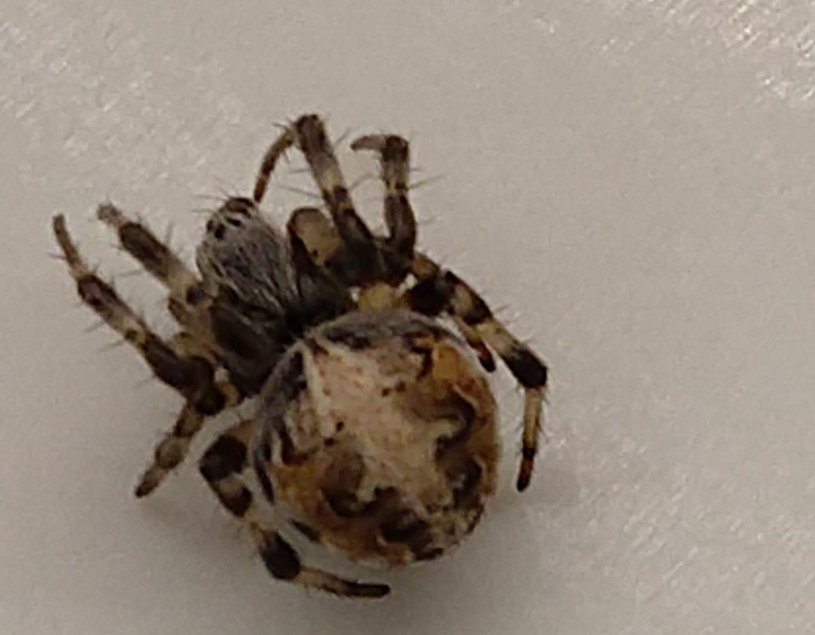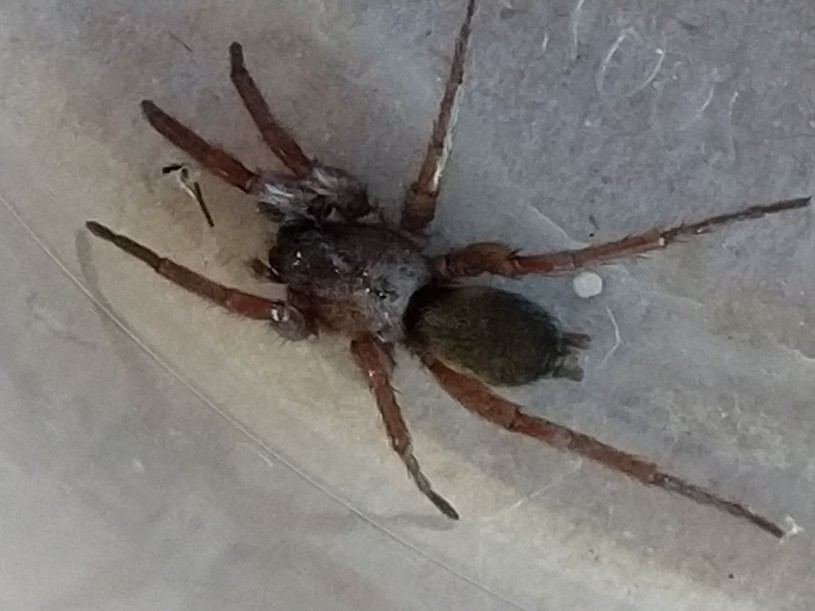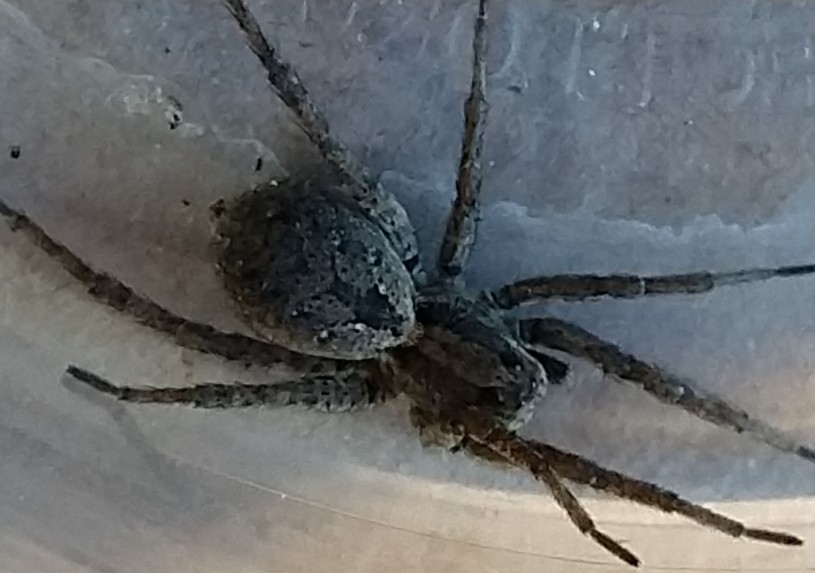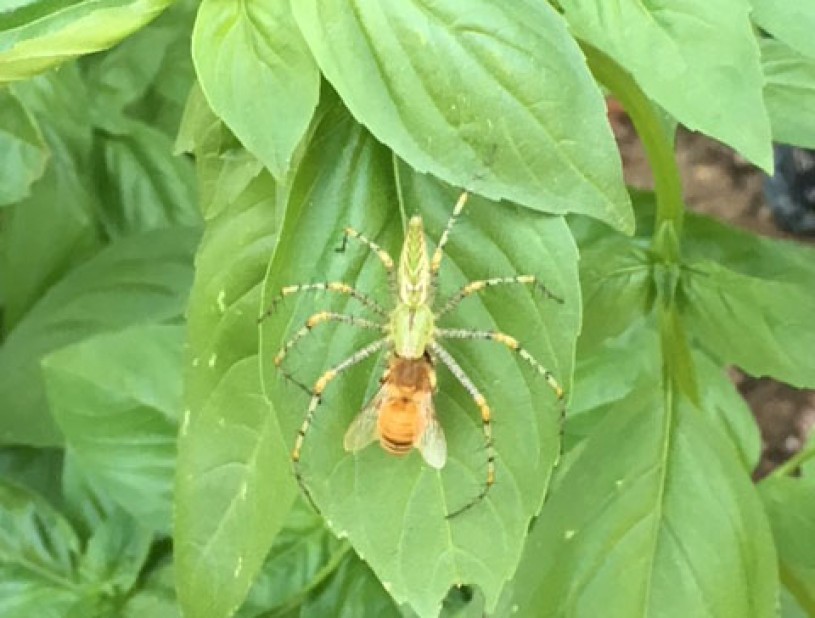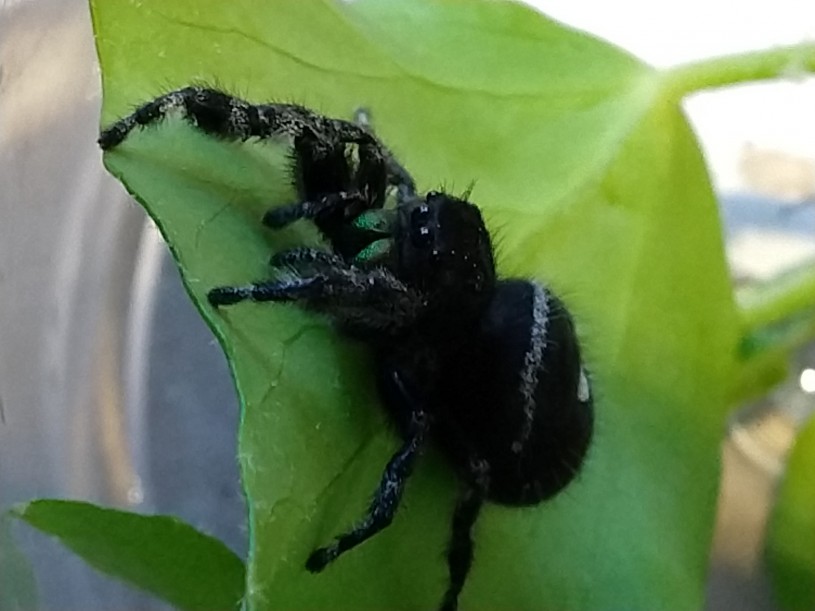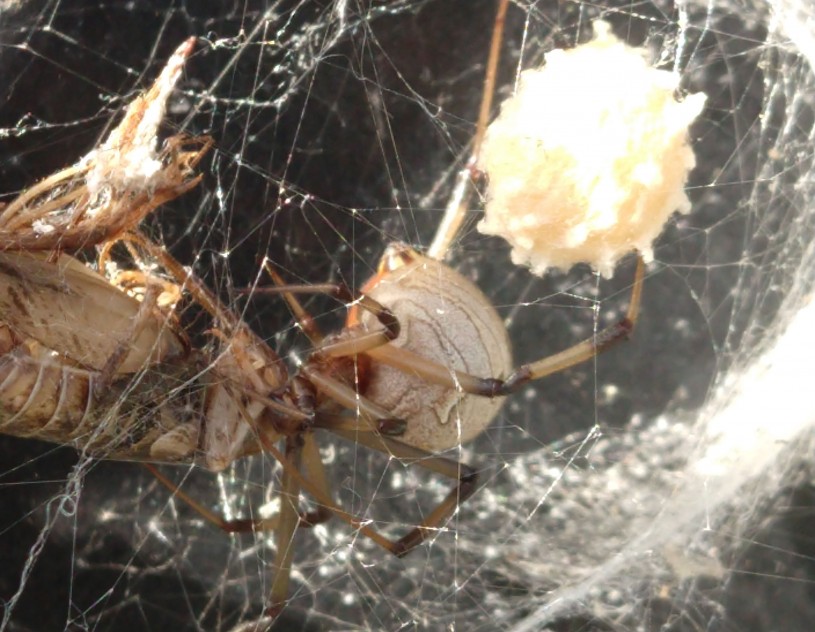Spider Survey
In order to conduct a large-scale survey of urban spiders, we need the help of the public. We are asking people to collect spiders in their homes and gardens, fill out a simple data sheet about their collection, and send or bring them to the Natural History Museum.
Once the specimens arrive here, our team of experts will identify the specimens, make a collecting record, and place the spiders in the collection. If requested, we will contact the person submitting the spider with information about its identity. Spiders collected in the survey will be used to create a database about the distribution and abundance of the species. We will report our major results on this website.
Want to help? See the 'How to Participate' section below for instructions.
In spite of their importance and abundance, we do not know much about the spiders in Los Angeles. There are no truly large collections of urban spiders from this area, as most collectors concentrate on studying natural areas. As an important international port, new species of spiders from various parts of the world are always being accidentally introduced into the Los Angeles area, and some of these have established breeding populations. We need to know how widespread these introduced species have become, and how they have interacted with the native spiders. Also, we want to know how urbanization and the loss of natural habitat has affected populations and distributions of naturally occurring spiders.
How Will it Work?
Disclaimer: The museum appreciates your assistance in this scientific project. If you have any concerns about participating, we suggest you do NOT participate. The museum cannot be responsible for the treatment of bites or for any injury or illness resulting from the project.
How to Participate
Why Are We Conducting A Survey?
Spiders are extremely important animals. They exist in vast numbers and are the primary predators of the equally common insects. Because they are so common, they often come into contact with people, and we receive many telephone calls requesting information about spiders. Many people needlessly fear spiders, but most are harmless to humans.
Go on a Spider-Collecting Adventure
Help our scientists find out which spiders are in L.A. Without your help, they can't get the full picture. Although the widows are the only spiders in our area which are considered dangerous, all spiders (except one family) have venom and may bite. Use caution collecting and do not put your hands anywhere you cannot see. If looking under rocks or logs, lift from the far side so that the object is between you and any creature living underneath.
Here's how:
Step 1: Gather Tools
Here's what you might use:
- plastic container(s) with lids
- plastic spoon
- gardening trowel
- old white pillowcase
- data sheet (PDF)
- small note card
- yogurt cups
Step 2: Go Outside
Spiders are everywhere. You just have to look—in bushes and flowers, under rocks, bricks and logs, wrapped in retreats tucked into leaves, in leaf litter, under pots, in crevices, in walls and fences, on window sills. The longer you spend quietly looking, the more you will find. Sometimes you will come across a spider wandering. Since many spiders are nocturnal, look at night too.
Step 3: Collect Spiders
To capture a spider, place a plastic container over the spider. Then slide a notecard beneath the spider to trap it. Quickly put the lid on the container.
To collect spiders from leaf litter, search for piles of leaves, like under bushes or in flowerbeds. With a trowel, scoop some dirt and leaves onto a pillowcase. Use a spoon to stir the material around while looking for spiders. Watch out they can move fast!
To collect nocturnal wandering spiders, try a pitfall trap. Bury a container like a yogurt cup flush with the ground. Smooth the ground around the lip. Add 1 inch of water. Check daily for spiders and place any spiders in a small container of rubbing alcohol to preserve it
Step 4: Send Us Your Spiders
Fill out the data sheet. Make sure to note where you found the spider. Bring your spiders to the Museum's front desk. Or put them in a small container, like a plastic pill vial. If alive, include a small piece of paper towel. If dead, include a cotton ball soaked in rubbing alcohol to preserve it.
Mail them to:
Spider Survey
Natural History Museum of Los Angeles County
900 Exposition Boulevard
Los Angeles CA 90007
What have we collected so far
Community scientists participating in the Los Angeles Spider Survey have collected over 4000 spiders, representing 217 species and 119 genera in 36 families.
Grass Spiders or Funnel Web-Weavers
Ghost Spiders
Orb-weavers
Sac Spiders
Trap-door Spiders
Meshweavers
Sow bug Eater
Sac Spiders
Crevice Weavers
Ground Spiders
Wolf Spiders
Pirate Spiders
Flatmesh Weavers
Goblin Spiders
Lynx Spiders
Running Crab Spiders
Cellar Spiders
Jumping Spiders
Violin Spiders
Giant Crab Spiders
Long-jawed Orb Weavers
Tarantulas
Cobweb Weavers
Crab Spiders
Hackled Band Orb-Weavers
Spider Biology | What is a Spider?
Everyone recognizes a spider on sight, but what are they really seeing? Spiders are classified as arthropods, in the same Phylum as insects.
Kingdom: Animalia
Phylum: Arthropoda, invertebrates with an exoskeleton and jointed appendages
Order: Arachnida, those with two body parts, and includes scorpions, ticks and mites, as opposed to insects which have three
Class: Araneae, spiders, which have:
- 8 legs
- 2 body parts – the cephalothorax and abdomen
- Spinnerets capable of producing silk
- Fangs capable of injecting venom
Only spiders share this unique set of characteristics.
Most spiders have 8 eyes; a few have 6, 4 or 2, and a small number, mostly cave dwellers, have none.
The defining characteristic of spiders is their ability to spin silk. Although all make silk, only some use that silk for prey capture. Most familiar are the orb webs of the Araneidae or orb weavers and the Tetragnthidae or long jawed orb weavers. Other capture webs include the messy cobwebs of the combfooted spiders in the family Therdiidae, the sheet webs of the funnel web or grass spiders in the family Agelenidae and the Bowl and Doily webs of the Linyphiidae.
Webs
All spiders have spinnerets attached to the rear end of the abdomen, and all are capable of spinning silk. The silk is used for many different purposes. Many spiders spin webs to capture food; some also wrap their prey before eating it. Most use silk to wrap egg cases. Many use silk to create retreats under stones or within leaves or to line burrows or tunnels. Silken drag lines are played out to serve as safety nets. Newly hatched spiderlings release silk to act as parachutes allowing them to travel a safe distance from their predatory siblings.
The most obvious use of silk is the construction of webs. Orb weavers spin large vertical orb webs to capture insects. The spider may hide in a silken retreat attached to the web, or may hang in the web. Cobweb weavers weave tangled webs in which they hang upside down When an insect is trapped, the spider rushes to inject venom and subdue it. Some spiders wrap the prey with silk to secure it.
Feeding
Some spiders, such as orb weavers, cellar spiders, and cobweb weavers, spin webs to capture their prey. Other spiders actively hunt for their food. Wolf spiders, jumping spiders, sac spiders and ground spiders are examples of this group. Still others lie in wait until an insect comes within reach. Crab spiders often hide in flowers until a fly or bee lands, then grab it. Trapdoor spiders hide at the mouth of their burrows until an insect walks past, then rush out to grab it.
Spiders with weak jaws, such as cobweb weavers and cellar spiders, regurgitate digestive fluid onto the insect's body with its fangs, then suck up the liquified tissues, leaving the exoskeleton intact. Those with strong jaws, such as tarantulas, wolf spiders and orb weavers, use their jaws to crush the insect while regurgitating digestive fluid, then suck up the liquified tissues as well.
Reproduction
Reproductive structures are not clearly visible until the spider undergoes its final moult. In the male, the last segment of the pedipalp is enlarged into a complicated structure. When ready to mate, the male spins a sperm web on which he places sperm from an opening near the epigastric furrow. He then sucks up the sperm with his pedipalp to store until mating.
The reproductive organ of the female, the epigynum, is located along the epigastric furrow. The male approaches the female and transfers the sperm by placing his palp into the opening of the epigynum.
Although the Black Widow has a reputation for eating the male during mating, most males survive the procedure by approaching her carefully and leaving quickly. Different families follow specific courtship patterns. Orb web weavers signal their approach by strumming the threads of the web and waiting until the female indicates she is receptive. Jumping spider males perform a dance with their brightly colored front legs.
Following mating, the female will spin an egg case to protect her eggs. Cob web weavers hang the egg cases in their webs and remain close by. Green lynx spiders do the same. Wolf spiders attach the egg case to their spinnerets and carry it until it hatches. The young then spend their first weeks on their mother's back. Others, like ground spiders, leave their eggs in a silken case under a rock.
Spider Control
Many people are concerned about spiders in their homes and gardens and ask about controlling the population. However, spiders are a major factor in controlling insect populations, especially insect pests such as flies, mosquitoes and moths. And the only dangerous spiders in the Los Angeles area are the widows, the Black Widow and the Brown Widow. All others are considered harmless to humans.
Ground running spiders are extremely sensitive to chemicals and web building spiders seldom touch the substrate. Therefore, if an insecticide is used, it must be sprayed directly on the spider. Any insecticide is toxic and presents a potential hazard to beneficial insects, such as bees and butterflies, as well as to humans including children. Complete control is unlikely since spiders from adjacent areas will move in. Young of black widows have been observed to completely reinfest an area within one week. To discourage spiders indoors, webs can be removed with a broom. Webs on shrubs and buildings are best controlled with regular hosing with a water stream, the spiders will usually rebuild their webs elsewhere.
Spider Relatives
Scorpions: Family Scorpionidae
The Los Angeles area has several species of common scorpions. By far the most common in our area is the burrowing scorpion or swollen stinger scorpion Anuroctonus phaiodactylus. Though males may occasionally be found wandering, these scorpions normally remain in their burrows. The burrows are found on sloping hillsides and road cuts and are almond-shaped openings about 1 inch in width and are about 8 to 12 inches deep. The pincers are very heavy and the tail is slender. Males have a distinct swollen base at the point of the stinger.
The California common scorpion Paruoctonus sylvestrii has four dark stripes on its fairly heavy tail. Its pincers are slender and it is brown or tan in color. These scorpions are often found on rocky ground and open road cuts in our hilly areas.
The Arizona bark scorpion Centruroides exilicauda has been established in several very small populations in Orange County where they live under roof shingles and in palm tree leaves. These scorpions are the only truly dangerous scorpion in North America. They are about 3 inches in length, slender, reddish or tan in color with very thin, almost needle-like pincers and a slender tail.
Ticks: Family Acari
Several species of ticks, both hard and soft ticks, are found in the Los Angeles area. All fed on the blood of various vertebrates. Some are capable of transmitting diseases, such as Lyme disease.
Pill and Sow Bugs: Order Isopoda
These animals are actually crustaceans, as can be seen by their gills and antennae. There are few references to them, one key for the terrestrial isopods is Light's Manual: Intertidal Invertebrates of the Central California Coast, U. of C. Press, pp. 301-312.
The pillbug is completely ubiquitous everywhere European man has set foot. This isopod is capable of rolling into a ball when disturbed; only a few other rare local species can do this and these are mostly sea-shore or desert animals. It is commonly preyed on by Steatoda grossa (which may even be a specialist on them).
Porcellio sp. sow bugs: We have three species of these isopods. P. laevis is more common in moist areas and yards and is often numerous near streams. It tends to be smoother with more rounded front plates than P. dilatatum. P. dilatatum is perhaps slightly more common in dryer (but moist) areas and in gardens. It has a more granular, dry appearance with rearward projecting plates on the first segments.
P. scaber is occasionally found in our area near streams and in moist canyons, especially further up the coast. It is slightly more slender than P. laevis but otherwise similar.
Porcallionides pruinosus: These isopods have a powdery appearance and are smaller, more slender than Porcellio. They also tend to be slightly more active. Often seen in gardens alongside Porcellio and Armadillidium, they run rapidly with the body held higher. All of the above isopods (except perhaps P. scaber) tend to be common throughout our area and may all be found together in our area.
Ligia occidentalis is the common rock hopper or rock louse found on rocky shores along the coast. Some specimens can be over an inch in length and can run rapidly.
Ligidium gracilis is a small and very rarely seen isopod that can be found in wet leaf litter and stream-side soil in our mountain streams and in a few locations along the coast. It is much more common further north.
Several species of small isopods are common in marsh and beach debris along the coast; most in the genus Armadilloniscus.
Occasionally isopods are found which are bright blue in color. This is common in A. vulgaire, less so in Porcellio. The color is apparently due to a fungal infection.
Resources
Insects of the Los Angeles Basin, LA Co. M.N.H.
Spiders of California and the Pacific Coast States, by R. J. Adams
Common Spiders of North America, by Richard A. Bradley
Spiders and Their Kin, by H. Levi, Golden Press, N.Y.
How To Know The Spiders, by B.J. Kaston, Pictured Key Nature Series, Wm. C. Brown, Dubuque, Iowa. This is a partial list of those spiders which are frequently seen in the urban Los Angeles area and surrounding hills from The common spiders of Los Angeles, by Blaine Hebert (1987). A more complete list has been compiled for all of California by Steve Johnson and Don Boe, and is available from the author.
For a more technical reference see: Spiders of North America by D. Ubick et al. available through the American Arachnological Society.
